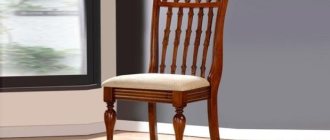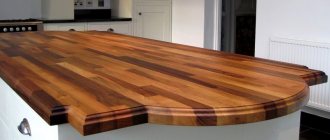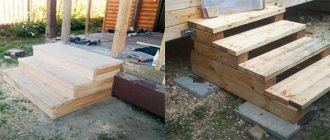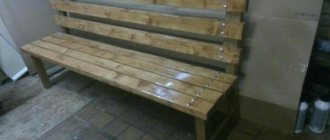There is a wide variety of wood stains, differing in color and composition. Wood will always be popular, because it is a beautiful and environmentally friendly material. However, like all natural decorative elements, boards are afraid of moisture and are a favorite habitat for insects, fungi, mold and other microorganisms. To increase the service life of things made from wood, various protective agents and antiseptics are used. Today we will talk about such a wonderful substance as stain, with its help you can not only solve some problems associated with premature damage to wooden materials, but also give your products an unusual and noble appearance.
What is wood stain
Wood is a strong and durable material that is susceptible to adverse environmental factors, therefore, in order to protect products made from it from possible damage, they must be treated with special means. On the construction market you can find a huge number of different antiseptics, varnishes and other impregnations that change the color and some properties of wood; the most popular and inexpensive product is stain. Some people think that stains are used only to change the color of an object, but this wonderful drug also has other properties.
The color of wood stain should be chosen depending on the interior design.
The properties of stains may vary depending on their composition. However, even if you do this tint yourself, it will still have some protective properties.
Properties of stains:
- If you want to change not only the color of the wood, but also highlight its texture, then stain is just what you need. It does not completely cover the design, like paint, but gives the entire product a pleasant shade.
- Staining wood will protect furniture from insects and rot, while maintaining the texture and grain of the wood.
- Stain is a protective agent that increases the service life of wooden objects and costs several times less than varnish and paint. In addition, due to its watery consistency, it penetrates deeper into the wood structure.
- With the help of stain, you can make even inexpensive pine, painted with colored stain, look like noble and strong oak and exotic mahogany.
- Tinting with stain can lighten the wood. This technique is especially often used before painting wooden products.
- Impregnation with stain will strengthen the structure of the wood and give it a slight moisture-proof property.
Not all stains have the above qualities. To understand what kind of stain you need, you need to read its composition and see what the instructions for use say. By the way, you can treat not only solid wooden boards with stains, but also chipboard, objects made of plywood or parquet and other wooden crafts.
Related article: DIY bed canopy: making a canopy
1r
1 reviews / Write a review
recommended products
Built-in wardrobe to order inexpensively
Built-in wardrobe is inexpensive..
3700 RUR
Sliding wardrobe made to order in individual sizes inexpensively
Custom-made sliding wardrobes are easy...
3700 RUR
colors, color, chipboard, mdf, choice of chipboard color, color, palette, what color to choose chipboard
Recently Viewed Products
All colors of chipboard and MDF
1r
Water-based wood stain and alcohol stains
Water-based stains are the most environmentally friendly stains. They do not have a strong unpleasant odor and are easy to use.
This product can be sold as a dry or ready-made mixture. Such dyes are most popular due to their low price and the possibility of their use for both interior and exterior work.
Water-based wood stain can significantly improve the appearance of wood flooring
Main characteristics of water stain:
- The colors of water-based stains are very diverse. With their help you can create a very interesting iridescent effect.
- You can use water sprays without fear for your health. Even at the highest temperatures, such products do not emit harmful fumes.
- If you decide to experiment and are wondering: “Which stain to choose so that it can be washed?” – then water stain is what you need. This tinting agent can be easily washed off with water, so painting the floor with it is impossible.
- Tinting a wooden surface with this method makes its texture more noticeable. Unfortunately, this makes the product more sensitive to moisture, so it will need to be opened with varnish.
It is extremely undesirable to tint resinous tree species with such impregnation, as unsightly stains may appear on them. For such products it is better to use alcohol impregnations.
How long does alcohol impregnation take to dry? Almost a few seconds! This property is both an advantage and a disadvantage. Thanks to it, you can cover the butt of a sporting rifle with alcohol stain, and use it in just a few minutes, however, a large area can only be stained with a spray gun, otherwise the surface of the product will become covered with unpleasant stains and stains, and even varnish will not help correct the situation. The alcohol impregnation consists of alcohol and dyes.
Treating wood with this impregnation will make it more resistant to ultraviolet radiation and high humidity. However, due to the unpleasant odor of this product, working with it is only possible in an open space.
Advantages and disadvantages
The use of stain has positive and negative properties; in order to understand whether this particular material is worth choosing, it is necessary to evaluate each aspect. The advantages of using the composition include:
- A variety of tint types that can give a wooden surface an unusual appearance;
- The grain of the wood is not lost, but rather stands out after processing the stain;
- Water-repellent coating structure;
- Antiseptics are included that protect the tree;
- Affordable cost of the composition.
But there are also disadvantages to these funds; experts note the points described below:
- There are types of stains that raise the fibers of the base, then it is necessary to sand the wood in advance to get a high-quality result without flaws;
- Not every type of stain is capable of creating a barrier from negative factors on a wooden base, and it is necessary to use other compositions;
- A number of products can only be used outside the building, and the master must wear protective gloves, a respirator and clothing;
- Some of the compositions are characterized by quick-drying properties; this requires the master to be able to cope with uniform distribution at a fast pace.
Antiseptics are turned on to protect the wood.
Advantages of oil-based stains and wax and acrylic stains
Oil-based stain comes in a wide range of colors and shades. It costs more than water sprays, but it also has more useful properties. This preparation can be used not only to change the color of the product, but also to emphasize its texture.
Treating wood with oil-based stain is easy and convenient; it is applied in a thin layer and does not lift the fibers of the product. Also, this tinting does not fade under the influence of sunlight, makes the wood resistant to temperature changes and protects it from moisture. Oil stains can be removed using white spirit solvent; it can also lighten painted wood a little. It differs from compositions with similar properties in that it does not require varnish to secure it. The disadvantages of staining with oil include: long drying of the tint and its toxicity.
Oil-based stain can be applied using a regular brush.
It is very important to find a stain from a responsible and conscientious manufacturer. Judging by the reviews, the most popular companies are Vartan, Latek, Novbytkhim and Herlak.
Acrylic and wax stains are very easy to apply; they apply in a uniform layer and do not leave stains or streaks. However, due to the rapid drying of such stains, you need to work with them very quickly.
Related article: Magnetic door lock - rules for choosing a mortise lock for an interior door
Wax stain is used to protect wood from moisture. It can be used to treat parquet. This stain is not resistant to mechanical damage, so to extend its service life, it is better to use varnish.
Acrylic, also known as rustic, stain perfectly emphasizes the texture of wood. With its help you can get a variety of shades, which is why this drug is so popular. Wood painted with such stain will still need to be opened with several layers of varnish.
Finishing wooden surfaces with stain: tips from TBM-Market specialists
To make the result pleasing, before starting finishing work you need to remember the simple rules of wood processing:
- To increase the depth of penetration into wood and improve adhesion to the surface, the composition should be slightly heated to a temperature of 36-38°C.
- The stain can be applied in different ways: rub in in a circular motion using a swab and longitudinally using a roller and brush.
- Wiping off excess must be done only along the fibers.
- To avoid blots and drips, do not dip the brush or swab into the solution too much.
- Do not apply a second layer of composition on the first one that has not dried.
- The ends and sections of wood that actively absorb the composition must be subjected to more intensive processing.
- Vertical surfaces of doors, panels, and walls should be coated starting from the bottom to prevent stains from being absorbed into unpainted wood.
- The procedure for applying layers can be repeated several times until the desired tone is achieved.
The ability to give boards a fashionable aged look is one of the additional advantages of water-based stain. The effect of achieving vintage antiquity begins with applying stain to the surface to be treated as the main background. Without letting it dry, in the right places where the imitation of scuffs will be placed, you need to quickly wipe off the dye. After complete drying, apply the next layer.
The stained surfaces of wooden gazebos, benches, and garden furniture are often lightly burned with a gas burner, which gives them a brighter, interesting look and enhances the appearance of texture. Firing is allowed only after the stain has completely dried. Then the surface is cleaned with a stiff shoe brush and varnished.
| Buy |
Wood stain colors
Wood stains differ not only in composition, they come in different colors and shades. Most often, a dark mixture is used; it gives the products a more noble appearance. With the help of such stains, ordinary larch and maple can be turned into oak boards.
Modern stains can give wood the most unusual shade. However, to this day the range of natural wood colors is considered the most popular.
Before choosing a wood stain color, you should study the designers' recommendations.
The most popular stain colors:
- Oak;
- Teak;
- Pine;
- Birch;
- Bleached walnut;
- Plum; Red tree;
- Olive;
- Rosewood;
- Beech.
There are many such examples. It is noteworthy that the names of the same shade from different companies can differ greatly. When choosing the color of stain, first of all, pay attention not to the color palette that is printed on the packaging, but to the samples printed on birch boards.
It is also important to consider that the intensity of the color of the stain depends on the type of wood on which it is applied. Giving a dark shade to an item if the wood from which it is made will be more difficult than darkening an oak item. A non-aqueous stain will not be able to stain a pine board well enough unless it is first desalted, but water-based stains are generally unsuitable for resinous wood species.
Creating effects
Alcohol or water stain can create an imitation of the naturalness of the coating without obvious traces of processing. When choosing a material for protection and painting, focus on the desired effect: choose a shade of oak, pine or ebony (as in the photo) - the interior will instantly be ennobled.
Products made from ash or oak do not need to be tinted - leave their structure and shade open, choosing the shade of this species that is as close to nature as possible.
Properly stained wood should retain its natural appearance. Only acrylic or wax stains stand out, the color range of which goes beyond naturalness.
The properties of each type of wood are different. In order not to make a mistake when purchasing, pay attention to the flower palette: the composition is applied to planks of different types, where you can see the final result.
White wood stain
To give your furniture a white color, you don't have to paint it. A lightening stain is also suitable for such work, which will not only make the product lighter, but also emphasize its structure.
Wood stain is intended not only to give the product a lighter shade, but also to protect it from adverse environmental conditions. It is very important to consider, when considering different types of such a product, how and what you will apply it to. If there is a risk that moisture will spill onto the surface of a bleached object, then it is best to use wax, oil and acrylic preparations, but if your craft will be in a dry and ventilated place, then water stain will also work.
With the help of white stain you can visually expand the room by applying it to the flooring or wooden walls
Using white stain you can achieve a very interesting effect and create an aged finish. It must first be painted with a white water-based stain; after it dries, the object must be treated with a stiff brush. A dark-colored wax or oil stain is rubbed into the formed pores on the wood.
When using water stain, do not forget about the protective layer. The painted product must be treated with wax or oil.
Light stains do not always have a pronounced color. There is a colorless stain that is applied solely to protect the wood from adverse natural factors.
Related article: Is your toilet or sink clogged? What to do? How to clear a clog?
Imitation
Manufacturers offer the most daring and non-standard furniture collections with original facade surfaces that imitate the texture of precious wood, leather or marble. A successful combination of furniture colors allows you to create unique modern or classic interiors. To create a harmonious and holistic space, it is necessary that the pieces of furniture are combined not only with each other, but also with the decorative decoration of the walls, floor or ceiling.
A special table has been developed for combining furniture color with wall decor:
- gray walls are in harmony with red, orange, blue or brown furniture;
- the pink background of the walls is successfully emphasized by decorative elements painted in deep blue, gray, light blue or white;
- Green walls blend organically with furniture in yellow, bluish, orange and grayish shades.
Color selection is the most important task; it must be solved at the initial stages of repair. It is necessary to take into account the combination of individual pieces of cabinet furniture with each other and with the finishing, to provide for the influence of color on the perception of the room and the emotional state of a person.
How to make your own stain
It is not necessary to buy ready-made stain. By mixing dyes such as coffee, a few drops of iodine or black bark shavings, and some chemical elements, it can be made at home. Homemade stain is not only effective, it is also natural.
A few tips on how to make your own stain:
- Boil a glass of larch bark in a glass of water. The resulting product can be used to coat birch products; it will give them a beautiful reddish tint.
- Grind the dried walnut shells into powder and boil for ten minutes. The resulting decoction must be mixed with soda. Apply the solution to light-colored wood and it will turn brown. If you want to change the color of the product, you can treat it with vinegar or potassium bichromate. In the first case, the shade will be gray, and in the second, red.
- Brewed tea or coffee can give the wood different shades. The intensity of the colors depends on the strength of the brew.
- Using a solution of potassium permanganate you will paint the product cherry color.
- A red tint can be achieved by soaking rusty nails in vinegar for several days. Black stain is obtained by adding a decoction of oak or walnut leaves to a vinegar solution.
To properly make stain with your own hands, you need to first watch the instructional video
They make their own stains quite often. They turn out to be environmentally friendly and harmless. Unfortunately, they all tend to fade, so to preserve the color of the product, you need to apply a layer of varnish over the stain.
Color variety
The most popular are natural shades of stains, which best harmonize with the wood. For furniture finishing, bog oak and walnut are often chosen. Wenge, mocha, and nutmeg will give wood a browner color. The burgundy palette includes mahogany, maple, and cherry.
You can achieve the desired shade by mixing several types of stains. It is important to maintain proportions and use mixtures from only one manufacturer. For larch and pine, both dark and light walnut options are suitable. This paint is classified according to the international standard. Each color has a name and its own code.
When choosing a mixture, a test coloring of the wood is carried out. The resulting shade will be influenced by the natural color and type of material. The quality and density of solutions is of great importance. Compositions with the same numbers from different manufacturers can produce shades of different saturation and depth.
Tinting wood with stain: step-by-step instructions
To make the product look neat and beautiful, you need to cover it with stain correctly. If the stain is applied poorly, it can fade in just a few weeks; also, if you do not follow the staining technology, you risk getting a surface covered with stains.
How to properly stain objects:
- First of all, it is necessary to remove a layer of old paint from the surface of the product. This can be done using sandpaper.
- Next, the surface is degreased with alcohol, white spirit or gasoline. If the product is made from resinous tree species, then it is deresined.
- The stain is heated and applied in a thin layer to the surface of the product. The top of the item is processed first. Layers are applied on top, one on top of the other, until the desired shade is achieved.
After the stain has dried, the product must be coated with several layers of varnish. Before applying a new layer, the dried varnish is treated with fine-grained sandpaper.
Flow calculation
The main indicator that must be taken into account when calculating consumption is the degree of porosity of the base material. Any stain has excellent absorbency. On average, one liter of composition is required per 15 m2. It is also important to consider the intensity of the shade. Conifers have low absorbency, so they will need to be processed in several layers to achieve the desired pattern, which will at least double the consumption.
The amount of material used is affected by the shape of the surface to be painted, the presence of corner locks, and hard-to-reach places. On each container of the mixture, manufacturers indicate how much mixture must be used to obtain a certain pattern. The exception is oil compositions, the task of which is to saturate the wood until the pores are completely filled. In this case, the type of tree and its condition are taken into account.
To reduce stain consumption when painting coniferous wood, it is necessary to remove tree resin from the base in advance.
How to prepare a wooden surface for finishing
The beauty and aesthetics of the finish depends not only on the quality of the stain, but also on the properly prepared surface. It should be smooth, silky, without scratches or other defects. Preparation for staining includes:
- thorough cleaning of wooden objects from dust, dirt, grease stains;
- removal of old paintwork;
- sanding and grinding;
- test coloring.
It is important for the home craftsman to know that sanding is always done along the grain. At the first stage, medium-grain sandpaper No. 120 is used for sanding, and at the second stage, fine sandpaper No. 220 is used. If furniture or other parts are made of coniferous wood, they must be deresined with a special compound. Grease stains are removed with a cloth moistened with alcohol or white spirit. Traces of wood glue are easily washed off with hot water.
When the first three conditions for preparing for staining have been met, it is necessary to do a test staining on a separate piece of board, which will help you choose the right color and its intensity.
Applying stain to a dry, clean and smooth surface is the key to a high-quality, beautiful finish.
Kinds
Depending on the type, you can divide the material obtained from young or more mature trees. Young and light-colored wenge materials are used to produce veneer and furniture panels. More mature and older trees are already used to create luxury furniture, billiard tables and other interior items.
More mature and older trees are used to create luxury furniture, billiard tables and other interior items.











